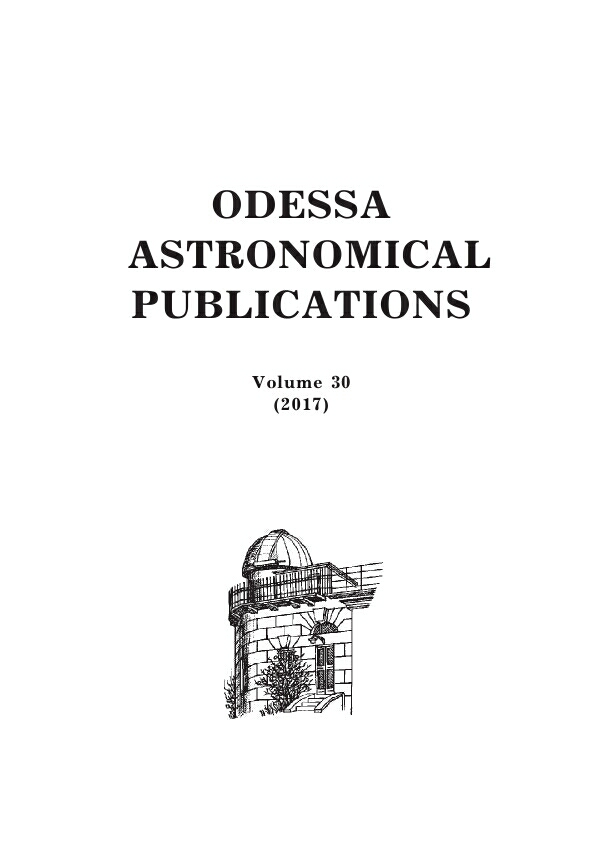RADIOACTIVE MOLECULES IN SN1987A REMNANT
DOI:
https://doi.org/10.18524/1810-4215.2017.30.114273Ключові слова:
SN1987A remnant, radioactive moleculesАнотація
The investigation of SN1987A remnant is complicated due to absence of the source of ionizing radiation, which should excite the remnant’s atoms and molecule. X-ray radiation from the shock wave front and, in accordance with recent observations, the intensity of X-rays significantly decreased during the last year made the backlighting of remnant. At the same time the intensity of molecular lines emission, localized near the front, abruptly increased. The remnant itself can be detected at the longer wavelength due to IR emission of dust component. One of the outburst’s results was the synthesis of radioactive isotope 4422Ti Its decay time is 85 years, the total mass of synthesized atoms is near the mass of Jupiter. The thermochemical analysis shows that during the last two years the remnant creates a set of diatomic molecules, which will be not a subject of thermal dissociation later. One of these molecules is the radioactive titanium oxide 4422Ti168O. We investigate the properties of diatomic molecules 4422Ti168O and 4421Sc168O before and after the radioactive decays of 4422Ti and 4421Sc. For oxides 4422Ti168O and 4421Sc168O the spectroscopic constants were calculated using the isotopic shifts with respect to well known 4422Ti168O and 4421Sc168O molecules. The isotope 4422Ti captures the electron from internal level. The result is the synthesis of new molecule 4421Sc168O. 4421Sc decays after 6 hours and creates the stable isotope 4420Ca, hard X-ray and γ -quanta and positron (e+). Additional result is the dissociation of molecule and the synthesis of stable neutral isotope 4420Ca after the sequence of decays 4422Ti → 4421Sc → 4420Ca. We found the energetic properties of transient molecules 4422Ti168O and 4421Sc168O. We first estimated the probabilities of radioactive transitions in the molecule 4422Ti168O during its transition to 4421Sc168O. We calculated the molecular transitions which allow to point the electronic, vibrational and rotational transitions during the decay 4422Ti → 4421Sc. The obtained results permit us to predict the new spectral lines and bands detection in the spectrum of SN1987A remnant. It will be emitted by transient molecules and can be identified in future observations.
Посилання
Dobrodey N.V.: 2001, A&A, 365, 642.
Frank K.A., Zhekov S.A., Park S. et al.: 2016, ApJ, 829, 40.
Grebenev S.A., Lutovinov A.A., Tsygankov S.S.: 2012, Nature, 490, 373.
Herzberg G.: 1949, Spectra and Molecular Structure (Van.Norst.Reinhold, N.Y.).
Huber K.P., Herzberg G.: 1979, Spectra and Molecular (Structure (Van. Norst. Reinhold, N.Y.).
Jorgensen U.G.: 1994, A&A, 284, 179.
Kozasa T., Yasegava H., Nomoto K.: 1989, ApJ, 344, 325.
Kuznetsova L.A., Kuzmenko N.E. Kuziakov Ia.Ia., et al.: 1980, Probabilities of optical transitions of diatomic molecules (Nauka, Moscow, in Russian).
Kuzmenko N.E., Kuznetsova L.V., Kuziakov Yu.Ia.: 1984, .The Framk-Condon Factors in diatomic molecules (MGU Publ. Moscow, in Russian).
Popov M.V., Filina A.A., Baranov A.A. et al.: 2014, ApJ, 783, 43.
Zel’dovich Ya.B., Raizer Yu.P.: 1966, The physics of shock waves and high temperature hydrodynamics phenomena (Nauka, Moscow, in Russian).
##submission.downloads##
Опубліковано
Номер
Розділ
Ліцензія
Авторське право (c) 2017 Odessa Astronomical Publications

Ця робота ліцензується відповідно до Creative Commons Attribution-NonCommercial 4.0 International License.
Відповідно Закону України про авторське право і суміжні права N 3792-XII від 23 грудня 1993 року
